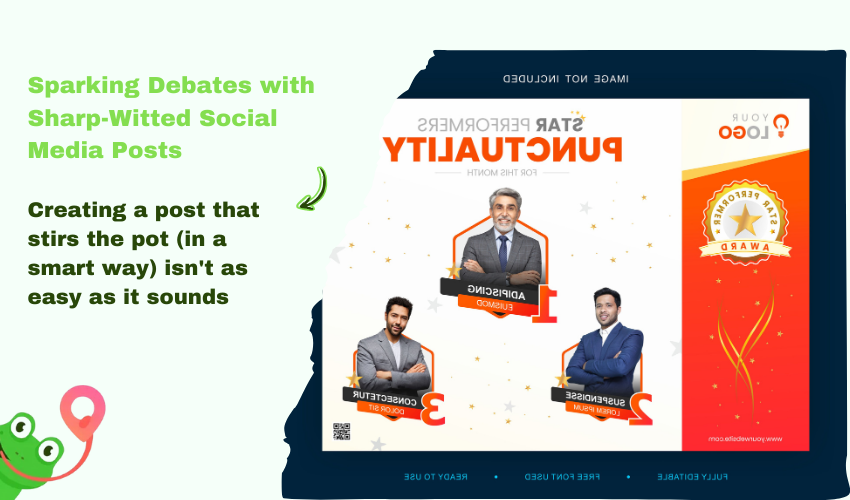Sparking Debates with Sharp-Witted Social Media Posts

Social media has revolutionized the way we communicate, especially when it comes to public debate. With just a few keystrokes, anyone can drop a punchy opinion that travels faster than wildfire. Whether it’s politics, culture, or everyday absurdities, platforms like Twitter, Instagram, and Threads have become battlegrounds of ideas, some constructive, others chaotic.
But amid the noise, it’s often the sharp-witted posts that gain the most attention. These clever, well-timed remarks spark engagement, fuel conversations, and challenge norms, all while keeping followers entertained.
While humor and brevity play major roles, the real magic behind these posts lies in their ability to provoke thought. They tap into hot-button issues or public frustrations, and present them in a bold, digestible, and sometimes sarcastic format. Whether you’re a brand, an influencer, or just someone who enjoys a good online debate, mastering the art of these posts can boost your visibility and impact.
The Rise of Wit as a Social Weapon

In the early days of social media, most content was casual: vacation photos, status updates, and links to news articles. Early social media featured casual content like vacation photos and updates, long before social media marketing services became essential. But as the platforms evolved, so did the tone of discourse. Users realized that a quick-witted comment could outperform even the most elaborate threads. This gave rise to a new breed of influencers, ones who rely not on selfies or dance trends, but on their ability to distill complex issues into sharp, meme-worthy commentary.
Sharp wit is now a form of currency online. It builds followings, invites engagement, and, perhaps most powerfully, triggers viral debates. In fact, a single clever remark can snowball into a larger public conversation, drawing in thousands of retweets, replies, and quote posts. The brevity demanded by platforms like Twitter forces users to think critically and creatively about how to make their point, often turning humor into a persuasive weapon.
How to Craft a Debate-Sparking Post
Creating a post that stirs the pot (in a smart way) isn’t as easy as it sounds. It’s not just about being loud or confrontational. It’s about tapping into the cultural moment, being concise, and offering a new perspective, ideally, one that challenges the status quo.
Here are a few strategies:
- Know your audience: Before posting, ask yourself who you’re talking to. A joke that lands perfectly with Gen Z might fall flat, or worse, offend, another demographic. Tailor your voice to resonate with your followers.
- Time it right: Posting in response to trending news or hot conversations increases the chances of your post gaining traction. The first few hours of a trending topic are often the most impactful.
- Keep it tight: One-liners, punchy takes, or quick memes are more likely to be shared. Avoid long-winded rants unless you’re offering unique insight. In most cases, less is more.
- Be ready for blowback: If you’re going to make bold claims, be prepared for criticism. Engaging in a debate means others will push back, often aggressively. Stay calm, respond with grace (or wit), and avoid taking things personally.
The Line Between Clever and Controversial

There’s a fine balance between sparking debate and provoking outrage. When humor becomes too sharp or targets sensitive topics without nuance, it can backfire. Social media is full of examples where a seemingly clever post caused a PR nightmare or led to online backlash.
The key is understanding intent versus impact. While your intention may be to start a conversation or be funny, the impact may not align if you’re not considering all perspectives. Humor rooted in truth and fairness tends to resonate more deeply than sarcasm aimed at punching down.
Moreover, it’s essential to differentiate between challenging ideas and attacking individuals. Ad hominem posts might get quick attention, but they often derail the discussion and diminish credibility. If your goal is meaningful dialogue, focus on the argument, not the person.
Satire, Memes, and the Power of Parody
One of the most effective ways to engage an audience is through satire and parody. These forms of expression allow creators to critique societal norms, politics, or cultural phenomena in a lighthearted way that feels accessible. Memes in particular have become a universal language on social media, simplifying complex messages into easily shareable formats.
Accounts that specialize in this style, those known for clever takes and meme-heavy commentary, have carved out strong followings by consistently delivering content that toes the line between entertainment and enlightenment. A prime example is the rise of anonymous or pseudonymous users who post with flair and edge. The now-iconic catturd Twitter account showcases how humor, satire, and political commentary can intersect to create a massive online presence, all while remaining shrouded in mystery.
These personalities have mastered the formula: deliver consistent, relatable content that stirs conversation without becoming overtly hostile. They engage followers with an unapologetically sharp tone, often leading to viral moments that make it to mainstream media coverage.
Why Debates Matter (Even the Silly Ones)
At first glance, online arguments might seem like a waste of time. But debates, when done right, can be incredibly valuable. They expose people to new viewpoints, test assumptions, and create space for reflection. Even when they get messy, these discussions can serve as a litmus test for public sentiment and help shape cultural conversations.
Social media offers a uniquely democratic platform for this. Voices that were once unheard can now reach massive audiences. Of course, this accessibility also comes with the challenge of misinformation and polarization. Still, the potential for constructive exchange is there, especially when content is framed intelligently and with humor.
Even light-hearted debates (like whether pineapple belongs on pizza) play a role. They bring people together, spark laughter, and provide a low-stakes way to engage with others online. These interactions may seem trivial, but they create shared experiences and moments of connection that help humanize digital spaces.
Conclusion
In a fast-paced digital world filled with fleeting attention spans, a sharp-witted social media post can be your ticket to relevance. These posts don’t just entertain, they ignite discussions, challenge perspectives, and create lasting impressions. When crafted thoughtfully, they become more than just internet noise; they become catalysts for conversation and cultural commentary.
So whether you’re an aspiring influencer, a brand looking to stand out, or just someone with something to say, lean into the power of humor and insight. Just remember: the goal isn’t just to be clever, it’s to start a conversation worth having.


